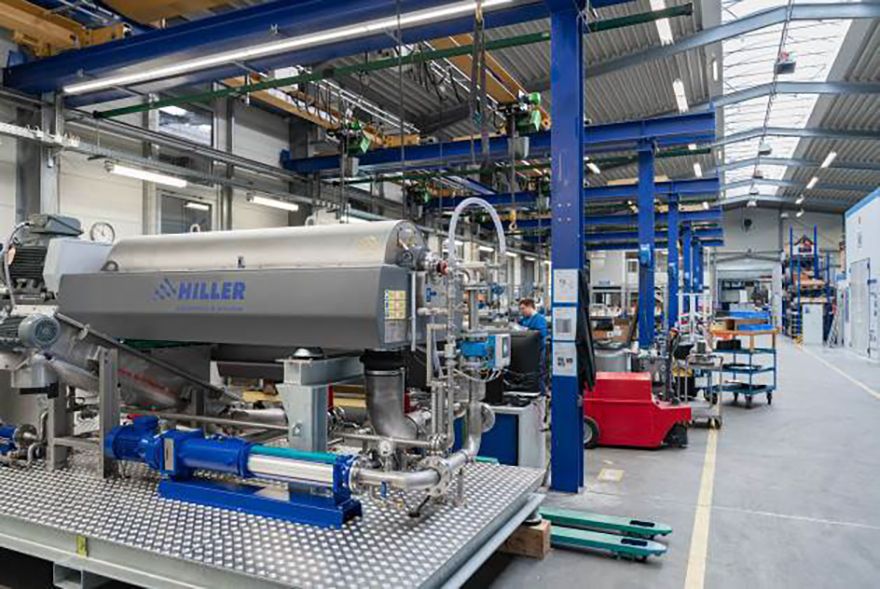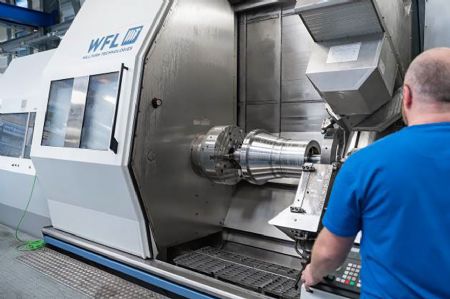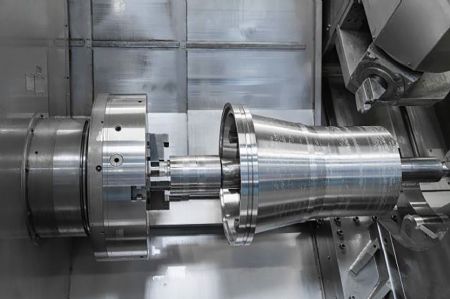 Over 6,500 centrifuges are already in use around the world, and around 200 decanter centrifuges are delivered to customers every year
Over 6,500 centrifuges are already in use around the world, and around 200 decanter centrifuges are delivered to customers every yearDecanter technology uses a process that separates liquids and solids. It is often used in industry to remove solid particles from liquids or to separate different liquids from one another. German company
Hiller GmbH has been developing and producing decanter centrifuges for over 50 years, using its expertise to solve separation tasks for customers across industrial sectors.
From fruit and vegetable juices, olive oil, fish processing, dairy products, kitchen waste, to sewage sludge treatment, algae harvesting, oil preparation or even the production of plant extracts, Hiller is involved in them all. The company’s decanters are used to separate milk and cream in the food industry, for instance, and to produce olive oil — in fact 80–90% of Spanish olive oil has gone through a Hiller decanter.
Another interesting application is in the chemicals industry, where decanters are used to separate solvents or to treat wastewater. In fact, wastewater treatment is probably the most important and sustainable area of use for this technology. Decanters are used to separate solids and liquids in sewage treatment plants for example — the accumulating sewage is cleaned using decanters so that it can then be released back into the waterways.
Centrifugal forceA decanter consists of a cylindrical housing with a rotating bowl inside which is divided into two sections by a partition wall. The liquid to be separated, whatever it may be, is fed into one section, while the end product and the solid material from the separation process are fed out into the other. When the bowl rotates, this creates a centrifugal force which pushes the solids to the outside. At the same time, the heavier liquids, such as water, sink towards the outer wall of the bowl where they then flow out. Lighter liquids like oil float to the surface of the heavier liquid and are also separated.
 Pictured right: the bowl bodies for the decanter centrifuges are produced on the M80 Millturn. The decanter bowl rotates at a high speed, causing solids to collect on the inner wall of the bowl
Pictured right: the bowl bodies for the decanter centrifuges are produced on the M80 Millturn. The decanter bowl rotates at a high speed, causing solids to collect on the inner wall of the bowlEssentially, decanter technology offers a very effective, very energy-efficient means of separating liquids and solids. Hiller produces the decanters in-house, manufacturing the majority of the decanter components at its site in Vilsbiburg, Lower Bavaria.
Hiller GmbH machines many different components for its decanter centrifuges using Millturn turning/
milling centres from Austrian company
WFL which are available in the UK via Market Harborough-based
Kyal Machine Tools.
At the heart of the decanter is a rotor, which comprises a screw conveyor, bowl and drive unit and is made entirely using WFL’s multi-tasking machines. In fact, the new M50 Millturn with 2,000mm centre distance is now used to produce additional parts that were previously bought in. Hiller’s in-sourcing strategy is one of its top priorities, especially in light of the recent supply chain challenges.
Stefan Brauner, head of production, said “The aim with the new WFL is to produce larger batches and to make optimal use of the machine’s capacity. The turning/milling machines have enabled us to really cut down the amount of equipment that we use. We have replaced several machining centres with the new WFL machine.
“The major benefit of making this change is that it simplifies the production process which used to be a long one — a component would be turned on one machine, then milled, and then turned again. Depending on requirements, the different production steps would be spread across different machining centres. Now everything is done on one machine, so there is no need for repositioning.”
Gear componentsThe company’s skilled engineers are also big fans of the machines. The M50, M80 and M120 trio makes a solid team and can handle a wide range of part sizes between them. On the larger WFLs, for example, the same chucks are used, with the machines mainly producing conical bowls, cylindrical bowls, screw conveyor bodies and front walls, etc. The M50 meanwhile is currently used to produce gear components.
 Pictured left: Bowl body for a centrifuge, manufactured in the newly acquired M50. The gear teeth are produced by means of gear hobbing
Pictured left: Bowl body for a centrifuge, manufactured in the newly acquired M50. The gear teeth are produced by means of gear hobbingThe large machines — the M80 and M120 — produce smaller batch sizes of between five and 10 pieces, while the new M50 produces 20 to 50 pieces in a two-shift operation. The benefits of complete machining are clear as the entire production process for a workpiece — including quality checks — takes place on one machine. The possibility of integrating a variety of tools in the machine speaks for itself. Overall, with complete machining it is the shorter set-up times and generally short lead times that really make the difference.
Mr Lehner, WFL sales manager, said: “The USPs of our machines include excellent stability thanks to the inclined bed concept. The machines have short distances between the machining point and the guideways, so maximum metal-cutting efficiency and high-precision finishing are guaranteed.”
When purchasing the complete machining centres, the key criteria were process reliability, service availability and, most importantly, the high quality of the machines. As Hiller had already been using an M80 and M120 for some time, the company knew that they could rely on the machines to run smoothly. This was a key factor behind the decision to purchase the new M50 Millturn.
Remote diagnosticsMr Brauner continued: “The very capable men and women at the other end of the telephone who are able to provide expert assistance should problems arise and the additional remote diagnostics service are great solutions. The user can establish a secure connection to WFL via PIN code, enabling a WFL service technician to quickly access the machine control system, identify the problem and perform diagnostics. This connectivity and the fast response times are simply fantastic.”
Mr Lehner added: “It is not only important for someone to be on site as quickly as possible when servicing is required in order to swiftly resolve the problem. What is particularly important for our customers is the time taken to resume production. All of our service employees are trained in all machine types and can therefore provide our customers with the best support on site.”
 Pictured right: the decanter screw conveyor consists of a spiral-shaped blade or a spiral. As well as aiding the separation of solids and liquids, the screw conveyor facilitates the removal of separated sludge
Pictured right: the decanter screw conveyor consists of a spiral-shaped blade or a spiral. As well as aiding the separation of solids and liquids, the screw conveyor facilitates the removal of separated sludgeAs the quality of its products is extremely important to Hiller, it was crucial to get the design of the technology right. CNC programmer Stefan Geiger explained that the machining process was developed in cooperation with WFL beforehand to ensure that the required gear components could be produced to the necessary degree of accuracy. He said: “WFL performed a very detailed preliminary examination of the component, so we could be confident that our production would be extremely accurate.”
Technologically speaking, the Millturns really do have everything covered. Work is currently under way to integrate the technological process of shaping. The idea would be for the complete machining centres to handle the internal gears of the gear components as well. External gears has already been successfully implemented with WFL’s technology cycles. The machining times for the different workpieces vary depending on the size of the component. The machining time for the bowl parts, for example, is a little longer — between 1.5 and 3.5hr. The majority of the workpieces are made from stainless steel, and the gear components predominantly from steel: these are materials that are ideal for processing with the WFL complete machining centre.
Perfect machining processProcess reliability is guaranteed on the M50 thanks to ‘iControl Advanced+’, which means that the machine can run completely automatically. The machine enables process signals to be monitored continuously at the machine control system, so even the smallest irregularity can be spotted immediately. If a wear-related overload or tool breakage is detected, the machine stops automatically. In addition, the possibility of integrated measurements enables tools to be corrected automatically — for the perfect machining process.
The CAD/CAM programming system ‘TopSolid’ is used for programming. Hiller is also now increasingly incorporating the WFL simulation and programming software ‘CrashGuard Studio’ into its processes, using this software for the final optimisation of programmes.